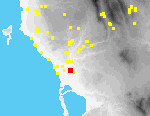 I02 Koryfasio Haratsari (Osmanaga Tholos)
I02 Koryfasio Haratsari (Osmanaga Tholos)
The tholos tomb at Haratsari-first excavated by Kourouniotis in 1926 and published by Blegen thirty years later-is located in relatively flat olive groves some 700 m. SW of the outskirts of modern Koryfasio; the ground around the tomb is slightly higher than in adjacent fields. There are bamboo and tall grass around the tomb[096.20]. When we first visited the site in 1991, both its dromos and chamber had been cleared, and they remained so in 1994; by 1995, however, the dromos had been filled with soil eroded from the adjacent olive groves, and about half the floor of the chamber was covered with colluvium. Recently, Korres and Lolos have reexamined the material, confirming the early date of the finds that indicate it is one of-if not the-earliest tholos tombs on mainland Greece (Korres 1981-82: 378-81; Lolos 1989). Korres identifies three phases in the tomb material, although it is difficult to assign them specific contexts: EH (from an underlying settlement); late MH-LH I/II; and LCL-HL reuse, possibly associated with cult. No finds of significance were made in the vicinity in the course of PRAP's tract-walking.
Four sherds were collected from this site: two Modern, two undatable.